1995 OLDSMOBILE SILHOUETTE lights
[x] Cancel search: lightsPage 142 of 390

Instrument Panel Cluster (3800 V6 Shown, 3.1L V6 Similar)
Your cluster includes indicator warning lights and gages that are explained on the following pages.
2-72
ProCarManuals.com
Page 145 of 390
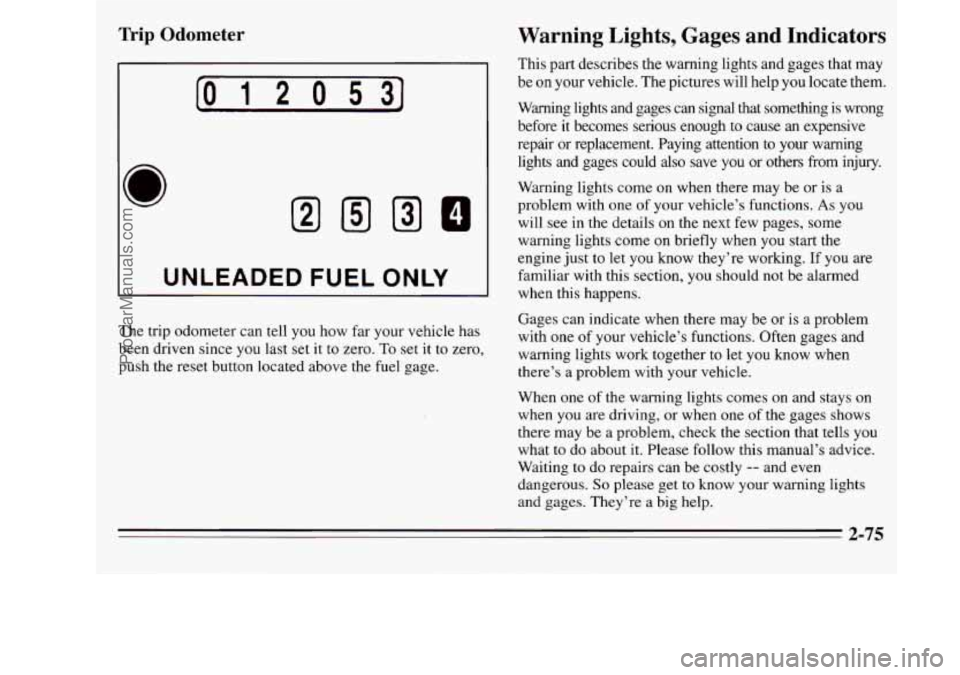
Trip Odometer
[O 12 O 531
I UNLEADED FUEL ONLY I
The trip odometer can tell you how far your vehicle has
been driven since you last set it to zero.
To set it to zero,
push the reset button located above the fuel gage.
Warning Lights, Gages and Indicators
This part describes the warning lights and gages that may
be on your vehicle. The pictures will help
you locate them.
Warning lights and gages
can signal that something is wrong
before it becomes serious enough to cause
an expensive
repair or replacement. Paying attention
to your warning
lights and gages could also save you or others
from injury.
Warning lights come on when there may be or is a
problem with one
of your vehicle’s functions. As you
will see in the details on the next few pages, some
warning lights come
on briefly when you start the
engine just to let you know they’re working.
If you are
familiar with this section,
you should not be alarmed
when this happens.
Gages can indicate when there may be or is a problem
with
one of your vehicle’s functions. Often gages and
warning lights work together to let
you know when
there’s a problem with your vehicle.
When one of the warning lights comes on and stays on
when
you are driving, or when one of the gages shows
there may be a problem, check the section that tells you
what to do about it. Please follow this manual’s advice.
Waiting
to do repairs can be costly -- and even
dangerous.
So please get to know your warning lights
and gages. They’re
a big help.
2-75
ProCarManuals.com
Page 198 of 390
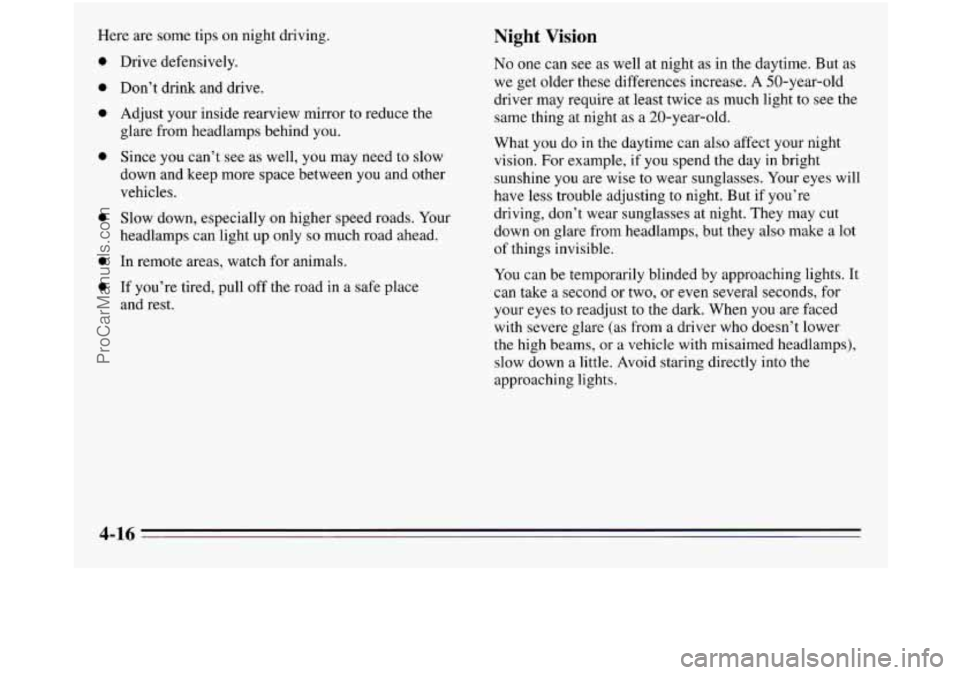
Here are some tips on night driving.
0
0
0
0
0
0
0
Drive defensively.
Don’t drink and drive.
Adjust your inside rearview mirror to reduce the
glare from headlamps behind you.
Since you can’t see as well, you may need
to slow
down and keep more space between you and other
vehicles.
Slow down, especially on higher speed roads. Your
headlamps can light up only
so much road ahead.
In remote areas, watch for animals.
If you’re tired, pull
off the road in a safe place
and rest.
Night Vision
No one can see as well at night as in the daytime. But as
we get older these differences increase. A 50-year-old
driver may require at least twice as much light to see the
same thing at night as a 20-year-old.
What
you do in the daytime can also affect your night
vision. For example,
if you spend the day in bright
sunshine
you are wise to wear sunglasses. Your eyes will
have less trouble adjusting to night. But if you’re
driving, don’t wear sunglasses at night.
They may cut
down on glare from headlamps, but they also make a lot
of things invisible.
You can be temporarily blinded by approaching lights. It
can take a second or two, or even several seconds, for
your eyes to readjust to the dark. When you are faced
with severe glare (as from a driver who doesn’t lower
the high beams, or a vehicle with misaimed headlamps),
slow down a little. Avoid staring directly into the
approaching lights.
4-16
ProCarManuals.com
Page 199 of 390
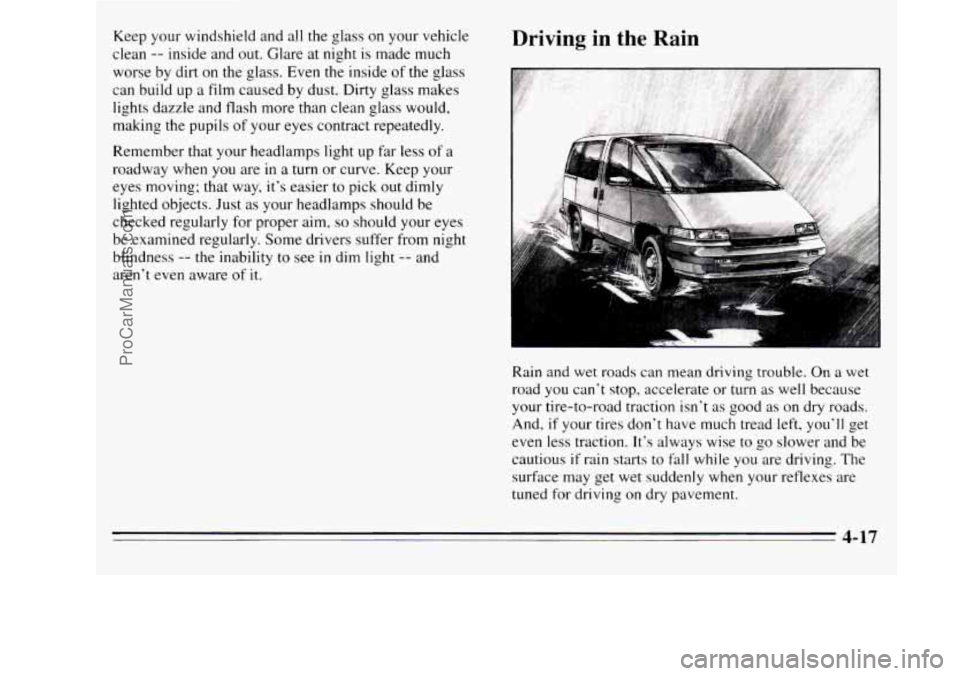
Keep your windshield and all the glass on your vehicle
clean
-- inside and out. Glare at night is made much
worse by dirt on the glass. Even the inside of the glass
can build up
a film caused by dust. Dirty glass makes
lights dazzle and flash more than clean glass would,
making the pupils of your eyes contract repeatedly.
Remember that your headlamps light up far less
of a
roadway when you are in a turn or curve. Keep your
eyes moving; that way, it’s easier to pick out dimly
lighted objects. Just as your headlamps should be
checked regularly for proper aim,
so should your eyes
be examined regularly. Some drivers suffer from night
blindness
-- the inability to see in dim light -- and
aren’t even aware of it.
Driving in the Rain
I
Rain and wet roads can mean driving trouble. On a wet
road
you can’t stop, accelerate or turn as well because
your tire-to-road traction isn’t
as good as on dry roads.
And, if your tires don’t have much tread left, you’ll get
even less traction. It’s always wise to
go slower and be
cautious if rain starts to fall while you are driving. The
surface may get wet suddenly when your reflexes are
tuned for driving on dry pavement.
4-17
ProCarManuals.com
Page 282 of 390
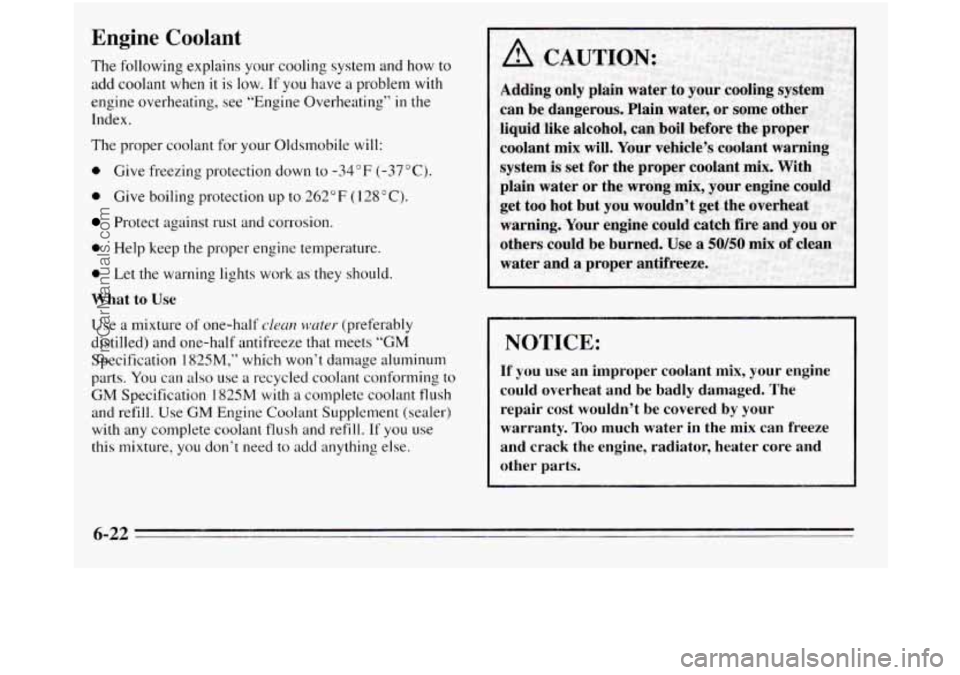
Engine Coolant
The following explains your cooling system and how to
add coolant when it is low.
If you have a problem with
engine overheating, see “Engine Overheating”
in the
Index.
The proper coolant for your Oldsmobile
will:
0 Give freezing protection down to -34°F (-37°C).
0 Give boiling protection up to 262 OF ( 128 ” C).
Protect against rust and corrosion.
0 Help keep the proper engine temperature.
0 Let the warning lights work as they should.
What to Use
Use a mixture of one-half clean water (preferably
distilled)
and one-half antifreeze that meets “GM
Specification
1825M,” which won’t damage aluminum
parts. You can also use a recycled coolant conforming to
GM Specification 1825M with a complete coolant flush
and refill. Use GM Engine Coolant Supplement (sealer)
with any complete coolant flush and refill.
If you use
this mixture,
you don’t need to add anything else.
NOTICE:
If you use an improper coolant mix, your engine
could overheat and be badly damaged.
The
repair cost wouldn’t be covered by your
warranty.
Too much water in the mix can freeze
and crack the engine, radiator, heater core and
other parts.
6-22
ProCarManuals.com
Page 382 of 390

......................................... Horn 2-39
Hydroplaning .................................. 4- 18 Key
Lock Cylinders
............................ 7-37
Key Reminder Warning
.......................... 2-23
Keys
.......................................... 2-1
&You’re Stuck
In Sand. Mud. Ice or Snow ......... 5-35
Ignition Key Positions
........................... 2-23
Ignition Switch
................................. 2-23
Illuminated Entry System
......................... 2-11
Inflator.
Air ................................... 2-63
Injector 3365 Fuse
.............................. 6-56
Inside Daymight Rearview
Mirror ................. 2-58
Brake System
............................... 7-39
Restraint Systems
............................ 7-39
Axle Boot and Sed ......................... 7-39
Throttle Linkage
............................. 7-39
Instrument Panel Cluster
......................... 2-72
Instrument Panel Intensity Control
................. 2-49
Instrument Panel. Cleaning
....................... 6-45
Integrated
Roof Antenna ......................... 3-23
Interior Lamps Control
........................... 2-55
Interior Lights Override Switch
.................... 2-56
Inspections
Exhaust Systems
............................. 7-39
Steering. Suspension and Front-Wheel-Drive
Instrumentpanel
............................... 2-70
Jack.
Tie .................................... 5-25
Jumpstarting
................................... 5-2 Lamps
...................................... 2-49
Lamps Control. Interior
.......................... 2-55
Lamps On Reminder
............................ 2-49
Lane Change Indicator
........................... 2-41
Larger Children. Safety Belt Use
................... 1-54
Latches. Side Window
........................... 2-39
Leaving
Your Vehicle ............................. 2-7
Leaving
Your Vehicle With the Engine Running ....... 2-35
Level Control. Electronic
......................... 2-68
Liftgate Ajar Warning Light
....................... 2-84
Liftgate Lock
.................................. 2-19
Liftgate. Raising
................................ 2-19
Lights Air Bag: Readiness
................. .... 1.27, 2.76 ......
Anti-LGck Brake System Warning ........... 2.78. 4.7
Brake System Warning ........................ 2-77
Liftgate Ajar Warning
......................... 2-84
Low Fuel Warning
........................... 2-85
Low Traction
............................ 2-80, 4-9
Power Sliding Door Warning
................... 2-84
Safety Belt Reminder
.................... 1-13, 2-76
Service Engine Soon
.......................... 2-81
TCS Warning ........................... 2.79, 4-9
Traction Control System Warning
........... 2-79, 4-9
9-6
ProCarManuals.com
Page 387 of 390
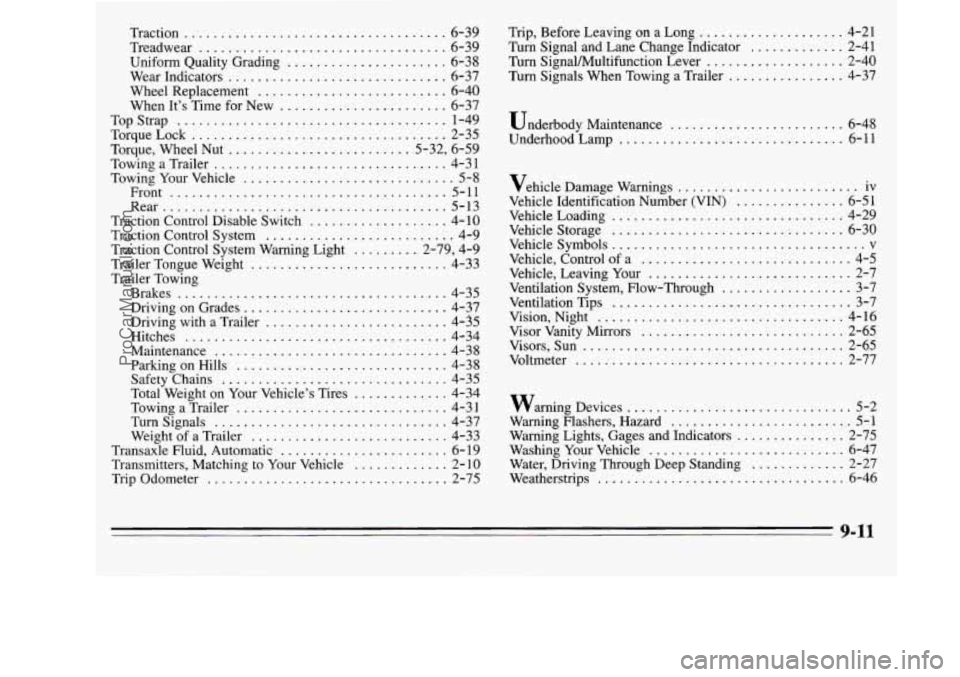
Traction .................................... 6-39
Treadwear
.................................. 6-39
Uniform Quality Grading
...................... 6-38
Wear Indicators
.............................. 6-37
Wheel Replacement
.......................... 6-40
When It’s Time for New
....................... 6-37
Top Strap
..................................... 1-49
TorqueLock
................................... 2-35
Torque. Wheel
Nut ......................... 5.32. 6.59
Towing a Trailer
................................ 4-3 1
Towing Your Vehicle ............................. 5-8
Front ...................................... 5-11
Rear
....................................... 5- 13
Traction Control Disable Switch
................... 4-10
Traction Control System
.......................... 4-9
Traction Control System Warning Light
......... 2-79, 4-9
Trailer Tongue Weight
........................... 4-33
Trailer Towing Brakes
..................................... 4-35
Driving on Grades
............................ 4-37
Driving with a Trailer
......................... 4-35
Hitches
.................................... 4-34
Maintenance
................................ 4-38
Parking on Hills
............................. 4-38
Safety Chains
............................... 4-35
Total Weight on Your Vehicle’s Tires
............. 4-34
Towing
a Trailer ............................. 4-31
Turnsignals
................................ 4-37
Transaxle Fluid, Automatic
....................... 6- 19
Transmitters, Matching to Your Vehicle
............. 2- 10
Trip Odometer
................................. 2-75
Weight
of a
Trailer ........................... 4-33 Trip. Before Leaving on a Long
.................... 4-21
Turn Signal and Lane Change Indicator
............. 2-41
Turn SignaVMultifunction Lever
................... 2-40
Turn Signals When Towing a Trailer
................ 4-37
Underbody Maintenance
........................ 6-48
Underhood Lamp
............................... 6-11
Vehicle Damage Warnings
......................... iv
Vehicle Identification Number (VIN)
............... 6-51
Vehicle Loading ................................ 4-29
Vehicle Storage
........................ : ....... 6-30
Vehicle Symbols
................................... v
Vehicle. Control of a ............................. 4-5
Vehicle. Leaving Your
............................ 2-7
Ventilation Tips
................................. 3-7
Vision. Night
.................................. 4-16
Visor Vanity Mirrors
............................ 2-65
Visors. Sun
.................................... 2-65
Voltmeter ..................................... 2-77
Ventilation System. Flow-Through
.................. 3-7
warning Devices
............................... 5-2
Warning Flashers. Hazard
......................... 5-1
Warning Lights. Gages and Indicators
............... 2-75
Washing Your Vehicle
........................... 6-47
Water. Driving Through Deep Standing
............. 2-27
Weatherstrips .................................. 6-46
9-11
ProCarManuals.com